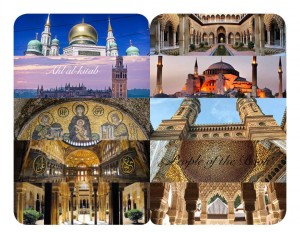People of the Book
Week 4: People of the Book and Religious Unity

Non-Muslims are often surprised to learn of references in the Quran to biblical and Hebrew figures and events. However, these references should not be unexpected because Muslims consider the Quran to be God’s third and final installment of revelation. As such the Quran is an affirmation and confirmation of the revelations that preceded it, which are said to all stem from God’s heavenly prototype of all scriptures (Asani 114). The term ahl al-kitab or “People of the Book” is meant to encapsulate this essential truth and refers to Jews, Christians and Muslims – or people that have received revelation in the form of scripture. The unity that this term purports can be seen in Quranic verse:
And argue not with the People of the Book unless it be in a way that is better, save with such of them as do wrong; and say we believe in that which has been revealed to us and to you; and our God and your God is one and unto Him we submit (29:46).
The piece I have created stems from the theme of unity among the monotheistic religions as seen through religious architecture. I have created a collage of photographs (some my own and others taken from the official websites of these religious structures) in the shape of a book. Some of these buildings such as the Hagia Sophia and the Cathedral of Saint Mary of the See in Seville, Spain have been used both as mosques and churches in different periods of time. In the third and fourth rows on the left for example are photos from the Hagia Sophia: one shows the Southwestern Entrance mosaic which depicts the Virgin Mary with child Christ and in the other Islamic calligraphy is clearly visible. The second photo on the left is of the Seville Cathedral and its famous bell tower La Giralda, which used to be the minaret of the ancient mosque that stood there prior to the Reconquista. The third photo on the right is of the Dohany Street Synagogue in Budapest, Hungary. While this synagogue has neither been a mosque or church prior to its construction its architectural style is quite similar to the Moorish style of the Alhambra, Alcazar, and Giralda in Spain (pictured on the top right and bottom of the collage). In fact, its architect, Ludwig Forster, deliberately chose “architectural forms that have been used by oriental ethnic groups that are related to the Israelite people, and in particular the Arabs”. Similarities can be seen between the Moscow Cathedral Mosque (first photo on the left) and the Hagia Sophia or Blue Mosque for example, due to its minarets and domes. And while the Moscow Mosque has a distinctive Russian twist (gold plated domes typical of Russian Orthodox churches), it still bears similarities to other mosques and places of worship around the world.
All of the buildings featured in the collage are extraordinarily beautiful, but even more striking are the similarities between them despite having been built in different time periods, geographic locations, and by people of different religions. This underlying unity is representative of the unity of the ahl al-kitab and showcases that despite some unique differences, the message of love for God is the same.
For a closer look at the collage visit this page.